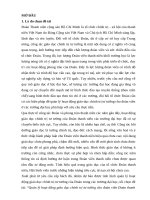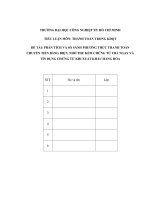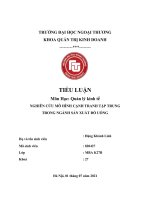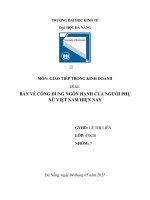(Tiểu luận) môn dự báo trong kinh doanh và kinh tế appendixd statistical tables
Bạn đang xem bản rút gọn của tài liệu. Xem và tải ngay bản đầy đủ của tài liệu tại đây (2.21 MB, 18 trang )
<span class="text_page_counter">Trang 1</span><div class="page_container" data-page="1">
Table D.1Areas under the Standardized Normal Distribution Table D.2<i>Percentage Points of the t Distribution</i>
Table D.3<i>Upper Percentage Points of the F Distribution</i>
Table D.4Upper Percentage Points of the χ
2Distribution
Table D.5A<i>Durbin–Watson d Statistic: Significance Points of d</i>
<i>L</i><i>and d</i>
<i>U</i>at 0.05 Level of Significance
Table D.5B<i>Durbin–Watson d Statistic: Significance Points of d</i>
<i>L</i><i>and d</i>
<i>U</i>at 0.01 Levels of Significance
Table D.6Critical Values of Runs in the Runs Test
Table D.7<i>1% and 5% Critical Dickey–Fuller t (= τ ) and F Values for Unit Root Tests</i>
Statistical Tables
</div><span class="text_page_counter">Trang 2</span><div class="page_container" data-page="2"><i>Note: This table gives the area in the right-hand tail of the distribution (i.e., Z ≥ </i>0). But since the normal distribution is symmetrical about <i>Z = </i>0, the area in the left-hand tail is the same as the area in the corresponding right-hand tail. For example,
<i>P</i>(−1.96 ≤ ≤ <i>Z </i> 0) = 0.4750. Therefore, (−1.96 <i>P</i> ≤ ≤ <i>Z </i> 1.96) = 2(0.4750) =0.95.
<i>Z</i>
</div><span class="text_page_counter">Trang 3</span><div class="page_container" data-page="3"><b>Percentage Points ofthe Distribution</b>
Source: From E. S. Pearson and
<i>H. O. Hartley, eds., BiometrikaTables for Statisticians, vol. 1,</i>
3d ed., table 12, Cambridge University Press, New York,
</div><span class="text_page_counter">Trang 4</span><div class="page_container" data-page="4"><b>880</b> <i>Appendix D Statistical Tables</i>
<b>TABLE D.3</b>
<b>Upper Percentage Points of the Distribution</b></div><span class="text_page_counter">Trang 6</span><div class="page_container" data-page="6"><b>TABLE D.3</b>
<b>Upper Percentage Points of the Distribution()</b></div><span class="text_page_counter">Trang 8</span><div class="page_container" data-page="8"><b>TABLE D.3</b>
<b>Upper Percentage Points of the Distribution()</b></div><span class="text_page_counter">Trang 10</span><div class="page_container" data-page="10"><i>= Z follows the standardized normal distribution, where k represents</i>
the degrees of freedom.
</div><span class="text_page_counter">Trang 11</span><div class="page_container" data-page="11"><i>Source: Abridged from E. S. Pearson and H. O. Hartley, eds., Biometrika Tables for Statisticians, vol. 1, 3d ed., table 8, Cambridge University Press, New York, 1966.Reproduced by permission of the editors and trustees of Biometrika.</i>
</div><span class="text_page_counter">Trang 12</span><div class="page_container" data-page="12"><b>TABLE D.5A</b>
<b>Durbin–WatsonStatistic: Significance Points of andat 0.05 Level of Significance</b></div><span class="text_page_counter">Trang 13</span><div class="page_container" data-page="13"><i>Note: n = number of observations, k</i><small></small>= number of explanatory variables excluding the constant term.
Source: This table is an extension of the original Durbin–Watson table and is reproduced from N. E. Savin and K. J. White, “The Durbin-Watson Test for Serial Correlation
<i>with Extreme Small Samples or Many Regressors,” Econometrica, vol. 45, November 1977, pp. 1989–96 and as corrected by R. W. Farebrother, Econometrica,</i>vol. 48, September 1980, p. 1554. Reprinted by permission of the Econometric Society.
<i>If n = 40 and k</i><i>= 4, dL= 1.285 and dU</i>= 1 721. . If a computed value is less than 1.285,<i>d</i>
there is evidence of positive first-order serial correlation; if it is greater than 1.721, there is no evidence of positive first-order serial correlation; but if lies between the lower and the<i>d</i>
upper limit, there is inconclusive evidence regarding the presence or absence of positive first-order serial correlation.
</div><span class="text_page_counter">Trang 14</span><div class="page_container" data-page="14"><b>TABLE D.5B</b>
<b>Durbin–Watson Statistic: Significance Points of and at 0.01 Level of Significance</b></div><span class="text_page_counter">Trang 15</span><div class="page_container" data-page="15"><i>Note: n = number of observations.</i>
<i>k</i><small></small>= number of explanatory variables excluding the constant term. Source: Savin and White, op. cit., by permission of the Econometric Society.
</div><span class="text_page_counter">Trang 16</span><div class="page_container" data-page="16"><b>TABLE D.6A</b>
<b>Critical Values of Runs in the Runs Test</b><i>Note: Tables D.6A and D.6B give the critical values of runs n for various values of N</i><small>1</small>(+symbol) and <i>N</i><small>2</small>(− symbol). For the one-sample runs test, any value
<i>of n that is equal to or smaller than that shown in Table D.6A or equal to or larger than that shown in Table D.6B is significant at the 0.05 level.Source: Sidney Siegel, Nonparametric Statistics for the Behavioral Sciences, McGraw-Hill Book Company, New York, 1956, table F, pp. 252–253. The tables have beenadapted by Siegel from the original source: Frieda S. Swed and C. Eisenhart, “Tables for Testing Randomness of Grouping in a Sequence of Alternatives,” Annals ofMathematical Statistics, vol. 14, 1943. Used by permission of McGraw-Hill Book Company and Annals of Mathematical Statistics.</i>
<b>TABLE D.6B</b>
<b>Critical Values of Runs in the Runs Test</b></div><span class="text_page_counter">Trang 17</span><div class="page_container" data-page="17"><i>In a sequence of 30 observations consisting of 20 + signs ( = N</i>1<i>) and 10 − signs ( = N ),</i>2
the critical values of runs at the 0.05 level of significance are 9 and 20, as shown by Tables D.6A and D.6B, respectively. Therefore, if in an application it is found that the number of runs is equal to or less than 9 or equal to or greater than 20, one can reject (at the 0.05 level of significance) the hypothesis that the observed sequence is random.
<b>TABLE D.7</b>
<b>1% and 5% Critical Dickey–Fuller () and Values for Unit Root Tests</b>*Subscripts nc, , and ct denote, respectively, that there is no constant, a constant, and a constant and trend term in the regression Eq. (21.9.5).<i>c</i>
<small>†</small>The critical <i>F v</i>alues are for the joint hypothesis that the constant and terms in Eq. (21.9.5) are simultaneously equal to zero.δ <small>‡</small><i>The critical F values are for the joint hypothesis that the constant, trend, and </i>δterms in Eq. (21.9.5) are simultaneously equal to zero.
<i>Source: Adapted from W. A. Fuller, Introduction to Statistical Time Series, John Wiley & Sons, New York, 1976, p. 373 (for the </i>τtest), and D. A. Dickey and W. A. Fuller,
<i>“Likelihood Ratio Statistics for Autoregressive Time Series with a Unit Root,” Econometrica, vol. 49, 1981, p. 1063.</i>
</div>








